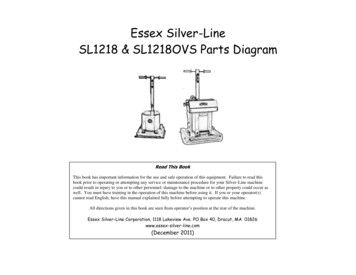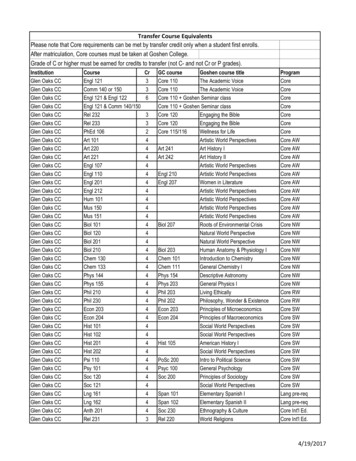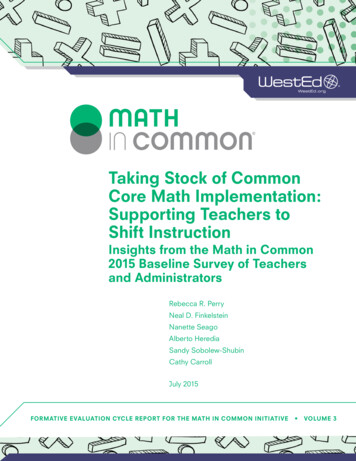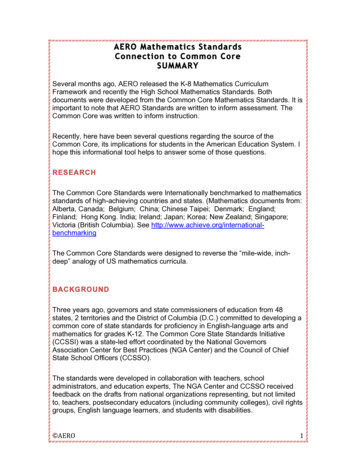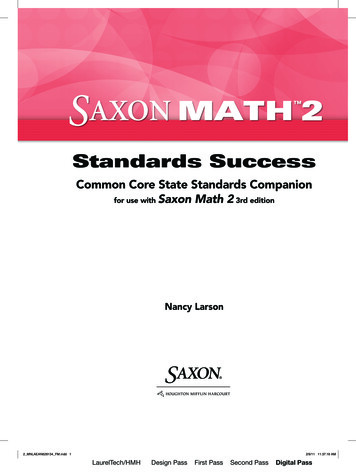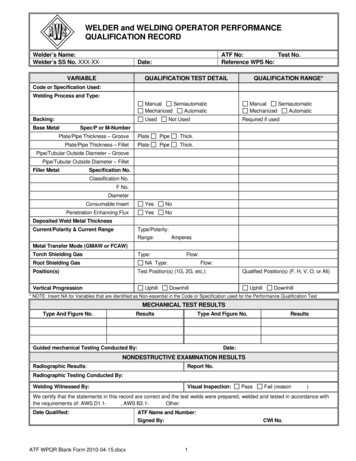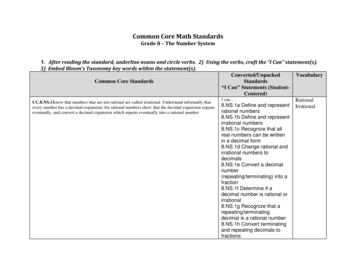
Transcription
Common Core Math StandardsGrade 8 – The Number System1. After reading the standard, underline nouns and circle verbs. 2) Using the verbs, craft the “I Can” statement(s).3) Embed Bloom’s Taxonomy key words within the statement(s).Converted/UnpackedVocabularyCommon Core StandardsStandards“I Can” Statements (StudentCentered)I can RationalCC.8.NS.1Know that numbers that are not rational are called irrational. Understand informally that8.NS.1aDefineandrepresentIrrationalevery number has a decimal expansion; for rational numbers show that the decimal expansion repeatsrational numberseventually, and convert a decimal expansion which repeats eventually into a rational number8.NS.1b Define and representirrational numbers8.NS.1c Recognize that allreal numbers can be writtenin a decimal form8.NS.1d Change rational andirrational numbers todecimals8.NS.1e Convert a decimalnumber(repeating/terminating) into afraction8.NS.1f Determine if adecimal number is rational orirrational8.NS.1g Recognize that arepeating/terminatingdecimal is a rational number8.NS.1h Convert terminatingand repeating decimals tofractions
8.NS.1i Distinguish betweenrational and irrationalNumbersCC. 8.NS.2 2.Use rational approximations of irrational numbers to compare the size of irrationalnumbers, locate them approximately on a number line diagram, and estimate the value of expressions(e.g., π 2). For example, by truncating the decimal expansion of 2, show that 2 is between 1 and 2,then between 1.4 and 1.5, and explain how to continue on to get better approximationsI can 8.NS.2a Estimate irrationalnumbers8.NS.2b Find the squareroots of perfect squares8.NS.2c Estimate the decimalfor a square root8.NS.2d Locate rationalnumbers on a number line8.NS.2e Locate irrationalnumbers on a number line8.NS.2f Locate theapproximate location ofirrationalnumbers on a number linebased on perfect squares8.NS.2g Construct a numberline that includes rationaland irrational numbers8.NS.2h Compare andcontrast irrational numbersidentifying larger vs. smallernumbers8.NS.2i Recognize if anumber is rounded or repeatswhen using a calculator8.NS.2j Determine whichnumber is bigger when givenany set of numbers written inany formSquare rootsPerfectsquaresNumber line
Common Core Math StandardsGrade 8 – Expressions and Equations1. After reading the standard, underline nouns and circle verbs. 2) Using the verbs, craft the “I Can” statement(s).3) Embed Bloom’s Taxonomy key words within the statement(s).Common Core StandardsConverted/Unpacked StandardsVocabulary“I Can” Statements (StudentCentered)I can IntegersCC.8.EE.1 Know and apply the properties of integer exponents to generate8.EE.1a Recognize integersExponentsequivalent numerical expressions. For example, 32 3–5 3–3 1/33 8.EE.1b Add and subtract integersEquivalent1/278.EE.1c Multiply and divide integersBases8.EE.1d Recognize exponentsAlgebraic8.EE.1e Fluently read exponentsexpression8.EE.1f Read equivalent expressionswith exponents8.EE.1g Generate equivalentexpressions withExponents8.EE.1h Identify the laws of exponentsincludingmultiplication, division, power of apower, and zeroexponents8.EE.1i Apply the laws of exponents
when multiplyingand dividing like and unlike bases8.EE.1j Convert bases with negativeexponents tofractions8.EE.1k Simplify algebraicexpressions, involving zeroexponents8.EE.1l Simplify algebraic expressions,involving negative exponents8.EE.1m Simplify algebraicexpressions, by applying themultiplication properties of exponents[exponents areadded]8.EE.1n Simplify algebraicexpressions, by applying thepower properties of exponents[exponents aremultiplied]8.EE.1o Simplify algebraicexpressions, by applying thedivision properties of exponents[exponents aresubtracted]8.EE.1p Simplify algebraicexpressions, using severalproperties
CC.8.EE.2 Use square root and cube root symbols to represent solutions toequations of the form x 2 p and x3 p, where p is a positive rational number. Evaluate square roots of smallperfect squares and cube roots of small perfect cubes. Know that 2 isirrationalCC. 8.EE.3 Use numbers expressed in the form of a single digit times aninteger power of 10 to estimate very large or very small quantities, and toexpress how many times as much one is than the other. For example,estimate the population of the United States as 3 108 and the populationof the world as 7 109, and determine that the world population is morethan 20 times larger.I can 8.EE.2a Evaluate square roots ofperfect squares.8.EE.2b Evaluate cube roots of perfectcubes8.EE.2c Recognize that non perfectsquares and cubes are irrational.8.EE.2d Recognizing the inverseoperation of squaredis square rooting8.EE.2e Recognizing the inverseoperation of cubed iscube rootingPerfect cubeCube rootInverseoperationI can 8.EE.3a Write numbers in scientificnotation8.EE.3b Use base 10 multiplication tocompare thevalues of numbers in scientific notation8.EE.3c Analyze values written inscientific notation8.EE.3d Distinguish between smalland large values ofnumbers in scientific notation bylooking at exponents8.EE.3eEstimate values written inscientific notation8.EE.3f Convert numbers fromscientific notation tostandard formScientificnotationStandard form
CC.8.EE.4 Perform operations with numbers expressed in scientificnotation, including problems where both decimal and scientific notation areused. Use scientific notation and choose units of appropriate size formeasurements of very large or very small quantities (e.g., use millimetersper year for seafloor spreading). Interpret scientific notation that has beengenerated by technologyCC.8.EE.5 Graph proportional relationships, interpreting the unit rate as theslope of the graph. Compare two different proportional relationshipsrepresented in different ways. For example, compare a distance-time graphto a distance-time equation to determine which of two moving objects hasgreater speed.I can 8.EE.4a Multiply numbers written inscientific notationusing the laws of exponents8.EE.4b Divide numbers written inscientific notationusing the laws of exponents8.EE.4c Interpret real-life situationsusing scientificnotations8.EE.4d Demonstrate knowledge ofscientific notationby using a calculator or other form oftechnology tosolve problemsI can 8.EE.5 Graph proportionalrelationships.8.EE.5 Interpret the unit rate as theslope of the graph.8.EE.5 Compare and contrastproportionalrelationships from a graph, table, ordescription8.EE.5 Analyze graphs, tables, andequations andexplain what is being represented8.EE.5 Identify that the slope is thesame betweenany two points on a line based on theproportionalrelationship of m y/xLaws ofexponentsProportionalUnit rateSlope
CC.8.EE.6 Use similar triangles to explain why the slope m is the samebetween any two distinct points on a non-vertical line in the coordinateplane; derive the equation y mx for a line through the origin and theequation y mx b for a line intercepting the vertical axis at b.I can 8.EE.6 Explain why triangles aresimilar8.EE.6 Determine the slope betweentwo points on acoordinate plane8.EE.6 Determine the slope betweentwo points using slope pt8.EE.6 Identify m as the slope of a lineand b as thepoint where the line intercepts the yaxis (y-intercept)8.EE.6 Construct an equation usingthe slope m andthe y-intercept b in the form of y mx b8.EE.6 Compare the sides of similartriangles by counting units tounderstand the slope of a non-verticalline is rise to run8.EE.6 Justify why the slope is thesame between anytwo points on a non-vertical lineCC.8.EE.7 Solve linear equations in one variable.a.Give examples of linear equations in one variable with one solution,infinitely many solutions, or no solutions. Show which of these possibilitiesis the case by successively transforming the given equation into simplerforms, until an equivalent equation of the form x a, a a, or a b results(where a and b are different numbers).I can a.8.EE.7 I can solve one-variableequations including those with thevariables being on both sides of theequals sign.8.EE.7 Solve multi-step one-variableequations, withDistributivepropertyLike termsVariables
b.Solve linear equations with rational number coefficients, includingequations whose solutions require expanding expressions using thedistributive property and collecting like terms.variables on both sides of theequation.8.EE.7 Create an ordered pair tosupport my solutionand justification8.EE.7 Recognize one solution,infinitely manysolution, and no solution when solvingmulti-stepequationsI Can:b.8.EE.7 Solve linear equations by usingthe distributive property.8.EE.7 Solve multi-step one-variableequations, bycombining like terms.
CC.8.EE.8 Analyze and solve pairs of simultaneous linear equations.a. Understand that solutions to a system of two linear equations in twovariables correspond to points of intersection of their graphs, because pointsof intersection satisfy both equations simultaneously.b. Solve systems of two linear equations in two variables algebraically, andestimate solutions by graphing the equations. Solve simple cases byinspection. For example, 3x 2y 5 and 3x 2y 6 have no solutionbecause 3x 2y cannot simultaneously be 5 and 6.c. Solve real-world and mathematical problems leading to two linearequations in two variables. For example, given coordinates for two pairs ofpoints, determine whether the line through the first pair of points intersectsthe line through the second pair.I cana8.EE.8 Graph 2 linear equations,written in standard formon the same graph and find the pointof intersection (System of Equations)8.EE.8 Graph 2 linear equations,written in slope-intercept formon the same graph and find the pointof intersection (System of Equations)I Can:b.8.EE.8 Solve a system of equations bysubstitution,involving 1 solution.8.EE.8 Solve a system of equations bysubstitution,involving no solution [parallel lines]8.EE.8 Solve a system of equations bysubstitution,involving infinitely many solutions[same line]8.EE.8 Solve a system of equations byelimination,involving 1 solution.8.EE.8 Solve a system of equations byelimination,involving no solution [parallel lines]8.EE.8 Solve a system of equations byelimination,involving infinitely many solutionsSystem ofequationsSubstitutionsEliminationInfinite
[same line]8.EE.8 Distinguish between onesolution, no solution,and infinitely many solution bygraphing a system ofequations8.EE.8 Identify system of equationsthat have no solution or infinitely manysolutions through simple inspection8.EE.8 Rearrange linear equationsfrom slope interceptform to standard form and vice versain order to solve using a given method.I Can:c.8.EE.8 Examine real-world problemsand write the linear systems ofequations8.EE.8 Decide which method to usewhen solvingsystems of linear equations in realworld situations.8.EE.8 Explain how the point ofintersectionrepresents 2 linear equations
Common Core Math StandardsGrade 8 – Functions2. After reading the standard, underline nouns and circle verbs. 2) Using the verbs, craft the “I Can” statement(s).3) Embed Bloom’s Taxonomy key words within the statement(s).Common Core StandardsConverted/Unpacked Standards Vocabulary“I Can” Statements (StudentCentered)I can FunctionCC.8.F.1 Understand that a function is a rule that assigns to each input exactly one8.F.1 Define functionDomainoutput. The graph of a function is the set of ordered pairs consisting of an input and8.F.1 Identify the domain andRangethe corresponding output.1range of a relationRelation8.F.1 Calculate the y-value foran equation whengiven the x-value8.F.1 Calculate the x-value foran equation whengiven the y-value8.F.1 Create a table for anequation8.F.1 Determine if a table is afunction8.F.1 Represent a function in theform of orderedpairs (table) and graphs.I can Rate ofCC.8.F.2 Compare properties of two functions each represented in a different way8.F.2 Compare/contrast twochange(algebraically, graphically, numerically in tables, or by verbal descriptions). Forfunctions with the sameexample, given a linear function represented by a table of values and a linearrepresentation (graphically,function represented by an algebraic expression, determine which function has thenumerically, verbally)greater rate of change.8.F.2 Compare/contrast twofunctions with differentrepresentations
8.F.2 Compare functionsrepresented in differentforms to determine which hasthe greater rate ofchange (slope) **CC. 8.F.3 Interpret the equation y mx b as defining a linear function, whosegraph is a straight line; give examples of functions that are not linear. For example,the function A s2 giving the area of a square as a function of its side length is notlinear because its graph contains the points (1,1), (2,4) and (3,9), which are not on astraight line.CC.8.F.4 Construct a function to model a linear relationship between two quantities.Determine the rate of change and initial value of the function from a description of arelationship or from two (x, y) values, including reading these from a table or from agraph. Interpret the rate of change and initial value of a linear function in terms ofthe situation it models, and in terms of its graph or a table of values.I can 8.F.3 Identify that non-linear isnot straight8.F.3 Use equations tocategorize functions as linearor non-linear8.F.3 Use graphs to categorizefunctions as linear ornon-linear8.F.3 Use tables to categorizefunctions as linear ornon-linearI can 8.F.4 Identify the slope and yintercept from a graph, table,and equation.8.F.4 Understand that the yintercept is the initialvalue of a function8.F.4 Construct an equationfrom a real-world situation8.F.4 Write an equation giventhe slope and y-intercept8.F.4 Determine the rate ofchange (slope) and the yinterceptgiven real-world situationsNon-linear
CC.8.F.5 Describe qualitatively the functional relationship between two quantitiesby analyzing a graph (e.g., where the function is increasing or decreasing, linear ornonlinear). Sketch a graph that exhibits the qualitative features of a function that hasbeen described verbally.I can 8.F.5 Identify the types of slopeas positive or negative, linear ornon-linear8.F.5 Analyze a graph of twoquantities (ie. distance overtime)8.F.5 Sketch the graph of afunction from a verbaldescription.8.F.5 Provide a verbaldescription of a function graph.
Common Core Math StandardsGrade 8 - Geometry1. After reading the standard, underline nouns and circle verbs. 2) Using the verbs, craft the “I Can” statement(s).3) Embed Bloom’s Taxonomy key words within the statement(s).Common Core StandardsConverted/Unpacked StandardsVocabulary“I Can” Statements (StudentCentered)I can RotationsCC.8.G.1 Verify experimentally the properties of rotations, reflections, and8.G.1 Define congruentReflectionstranslations. A) Lines are taken to lines, and line segments to line segments8.G.1 Construct an image from pre- Translationsof the same length. B) Angles are taken to angles of the same measure. C)image, usingTransformationsParallel lines are taken to parallel lines.geometric tools.Congruent8.G.1 Construct a rotation,reflection, translations8.G.1 Justify that an image and preimage arecongruent for all transformationsusing compasses, protractors, andrulers.8.G.1 Recognize the angles formedby two parallellines and a transversal8.G.1 Justify why angles(formed byparallel lines anda transversal) are congruent usingangle relationships
CC.8.G.2 Understand that a two-dimensional figure is congruent to another ifthe second can be obtained from the first by a sequence of rotations,reflections, and translations; given two congruent figures, describe a sequencethat exhibits the congruence between them.CC.8.G.3 Describe the effect of dilations, translations, rotations, andreflections on two-dimensional figures using coordinates.CC.8.G.4 Understand that a two-dimensional figure is similar to another ifthe second can be obtained from the first by a sequence of rotations,reflections, translations, and dilations; given two similar two-dimensionalfigures, describe a sequence that exhibits the similarity between them.I can 8.G.2 Determine if two figures arecongruent byidentifying the transformation usedto produce thefigures8.G.2 Recognize the symbol forcongruency ( ) and writestatements of congruency8.G.2 Describe the sequence oftransformations fromone figure to anotherI can 8.G.3 Identify the new coordinatesof a translation8.G.3 Identify the new coordinatesof a reflection8.G.3 Identify the new coordinatesof a rotation8.G.3 Identify the new coordinatesof a dilation8.G.3 Understand image and preimage are similar indilationsCongruency( )I can 8.G.4 Describe that the angles ofsimilar figuresare congruent and the sides ofsimilar figures areproportional8.G.4 Produce similar figures fromdilations usingscale factorsSimilarSymbolDilationCoordinates
8.G.4 Describe the list of steps thatwould producesimilar figures when given the scalefactors (dilation)8.G.4 Differentiate between scalefactor that wouldenlarge a figure’s size and one thatwould reduce itCC.8.G.5 Use informal arguments to establish facts about the angle sum andexterior angle of triangles, about the angles created when parallel lines are cutby a transversal, and the angle-angle criterion for similarity of triangles.I can 8.G.5 Find the missing angle of atriangle.8.G.5 Find the measures of missingangles8.G.5 Find the exterior angle of atriangle8.G.5 Make conjectures aboutrelationships betweenangles8.G.5 Determine the relationshipbetween two angleswhen given parallel lines and atransversal.8.G.5 Find the missing anglemeasure when given twosimilar triangles.8.G.5 Construct various trianglesand find themeasures of interior and exteriorangles8.G.5 Explore and justifyrelationships that existbetween angle sums and exteriorangle sums of
triangles8.G.5 Explore and justifyrelationships that existbetween angles created whenparallel lines are cut bya transversal8.G.5 Explore and justifyrelationships that existbetween the angle – angle criterionfor similarity oftriangles8.G.5 Construct various trianglesand find measuresof the interior and exterior angles8.G.5 Form a hypothesis about therelationshipbetween the measure of an exteriorangle and theother two angles of a triangle8.G.5 Apply my knowledge of anglerelationships tofind the measure of missing angles8.G.5 Construct parallel lines andtransversal toexamine the relationships betweencreated angles8.G.5 Apply my knowledge ofvertical, adjacent, andsupplementary angles to identifyother pairs ofcongruent angles8.G.5 Construct triangles havingline segments ofdifferent lengths but with twocorresponding congruent
angles8.G.5 Compare ratios of sides tofind a constant scalefactor of similar trianglesCC.8.G.6 Explain a proof of the Pythagorean Theorem and its converse.I can 8.G.6 Understand the PythagoreanTheorem8.G.6 Use the PythagoreanTheorem to find themissing side of a right triangle.8.G.6 Use the PythagoreanTheorem to determine ifthree length measurements form aright triangle8.G.6 Identify the parts of a righttriangle (legs andhypotenuse)8.G.6 Recognize the diagonal of aparallelogram withright angles as the hypotenuse ofthe right trianglesformed8.G.6 Verify the PythagoreanTheorem by examiningthe area of squares coming off ofeach side of the righttriangle8.G.6 Determine if a triangle is aright triangle byusing the Pythagorean Theorem8.G.6 Identify Pythagorean triples8.G.6 Explain a proof of thePythagorean Theorem
CC.8.G.7 Apply the Pythagorean Theorem to determine unknown sidelengths in right triangles in real-world and mathematical problems in two andthree dimensions.CC.8.G.8 Apply the Pythagorean Theorem to find the distance between twopoints in a coordinate system.I can 8.G.7 Solve word problems usingthe PythagoreanTheorem8.G.7 Apply the PythagoreanTheorem to determineunknown side lengths in righttriangles in real-worldproblems in 2 dimension and 3dimensions8.G.7 Apply the PythagoreanTheorem to determineunknown side lengths in righttriangles in mathematicalproblems in 2 dimension and 3dimensionsI can 8.G.8 Use the PythagoreanTheorem (instead of thedistance formula) to find thedistance between twopoints in a coordinate plane8.G.8 Construct a right triangle on acoordinate planeto determine the distance betweentwo points8.G.8 Determine the length of thediagonal orhypotenuse of a right triangle on acoordinate plane8.G.8 Use the coordinate plane tocreate a righttriangle relationship whereby thedistance between twopoints can be determined by
solving for thehypotenuse of the PythagoreanTheorem.CC.8.G.9 Know the formula for the volumes of cones, cylinders, and spheresand use them to solve real-world and mathematical problems.I can 8.G.9 Identify the shapes of cones,cylinders, andspheres8.G.9 Use appropriate formulas forvolume of cones,cylinders, and spheres inmathematical and real-worldsituations
Common Core Math StandardsGrade 8 – Statistics and Probability3. After reading the standard, underline nouns and circle verbs. 2) Using the verbs, craft the “I Can” statement(s).3) Embed Bloom’s Taxonomy key words within the statement(s).Converted/UnpackedVocabularyCommon Core StandardsStandards“I Can” Statements(Student-Centered)I can CC.8.SP.1 Construct and interpret scatter plots for bivariate measurement data toinvestigate patterns of association between two quantities. Describe patterns such asclustering, outliers, positive or negative association, linear association, and nonlinearassociation.8.SP.1 Graph a set of points8.SP.1 Interpret scatter plotas linear or nonlinear8.SP.1 Interpret scatter plotas positive, negative,constant, or no correlation.8.SP.1 Interpret the graph asstrong correlation(clustering) or weak (outliers)8.SP.1 Construct a scatterplot on a plane using twovariables8.SP.1 Investigate therelationship between twoquantities on a scatter plot8.SP.1 Predict futureoutcomes using a scatter plot8.SP.1 Analyze the trend of ascatter plot anddetermine whether there is apositive, negative(linear),
or no relationship(non-linear)8.SP.1 Describe patterns inthe data such asclustering and outliersCC.8.SP.2 Know that straight lines are widely used to model relationships between twoquantitative variables. For scatter plots that suggest a linear association, informally fit astraight line, and informally assess the model fit by judging the closeness of the datapoints to the line.CC. 8.SP.3 Use the equation of a linear model to solve problems in the context ofbivariate measurement data, interpreting the slope and intercept. For example, in a linearmodel for a biology experiment, interpret a slope of 1.5 cm/hr as meaning that anadditional hour of sunlight each day is associated with an additional 1.5 cm in matureplant heightI can 8.SP.2 Write the equation[line-of-best fit] for a scatterplot, by finding the slope andy-intercept.8.SP.2 Write the equation[line-of-best fit] for a scatterplot, using the calculator[STAT key]I can 8.SP.3 Graph the equation todemonstrate how thedata is related8.SP.3 Use the line of best fitto determine anequation in two variables forthe data (y mx b)8.SP.3 Use slope interceptform (y mx b) todetermine the slope and yintercept of the line of bestfit8.SP.3 Interpret the meaningof the slope and y interceptin the context of the datagiven
8.SP.3 Determine relevantinformation from graphCC.8.SP.4 Understand that patterns of association can also be seen in vicariatecategorical data by displaying frequencies and relative frequencies in a two-way table.Construct and interpret a two-way table summarizing data on two categorical variablescollected from the same subjects. Use relative frequencies calculated for rows or columnsto describe possible association between the two variables. For example, collect datafrom students in your class on whether or not they have a curfew on school nights andwhether or not they have assigned chores at home. Isthere evidence that those who have a curfew also tend to have chores?I can 8.SP.4 Determine if there is acorrelation between theinformation8.SP.4 Read a graph todetermine a correlation8.SP.4 Construct a graphbased on information given8.SP.4 Create a frequencytable with collected data8.SP.4 Interpret a frequencytable8.SP.4 Make predictions andanalyze the databetween the variables in thefrequency table8.SP.4 Justify and defend theaccuracy of mypredictions
Common Core Math Standards Grade 8 - The Number System 1. After reading the standard, underline nouns and circle verbs. 2) Using the verbs, craft the "I Can" statement(s). 3) Embed Bloom's Taxonomy key words within the statement(s). Common Core Standards Converted/Unpacked Standards "I Can" Statements (Student-Centered) Vocabulary
